Charles Taylor’s reign of terror in Liberia
As Charles Taylor is sentenced to 50 years in prison, Channel 4 News Foreign Editor Ben de Pear says his reign of terror in Liberia should not be forgotten.
In 2003, I was one of a small group of journalists trapped with Charles Taylor in the besieged capital of Liberia, Monrovia, as the rebel army of LURD sought to oust the President.
Using a band of drugged up militia featuring many child soldiers and teenage gangs, Taylor held out for weeks, before finally taking the option of exile In Nigeria.
Today he was sentenced to 50 years in prison for his support for the RUF rebels in Sierra Leone, whose own reign of terror ended with a British military intervention. But Taylor’s reign of terror in Liberia, which cost over a quarter of a million lives, countless atrocities, mass rapes and enforced child soldiering on a massive scale, should not be forgotten.
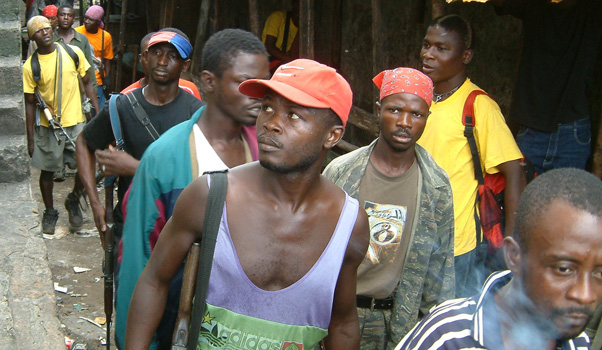
Locals referred to the fighting in 2003 as World War 3. World wars 1 and 2 involved Taylor as well.
By the time LURD had surrounded Monrovia in July 2003, Taylor had been indicted by the Hague for his involvement in Sierra Leone, so international support for him had crumbled.
To try and stay in power Taylor had flooded the streets with child soldiers, many dressed in fairy clothes, some in wigs, all high on cannabis, booze and whatever drugs their commanders gave them.
About 20 or so journalists stayed at the Mamba Point Hotel, which was about a mile from the main front line, which was the Old Bridge.
We would walk with some of the fighters up to the Taylor side of the bridge which was a market area. Here the fighters would lean against the wall passing large marijuana joints up and down the line, and then one by one they would emerge in a deadly game of do-or-dare and fire across the bridge in the most entertaining or as they saw it cool way possible; backwards, through the legs, spinning round and round.
Some older boys had rocket launchers.
On my first day experiencing this a fighter shouted at me “Are you scared man? Are you scared?”. “Yes” I replied. “There aint no point being born if you ain’t prepared to die”, came the reply.
It was a photographers paradise, and although deadly dangerous, was an adrenaline pumping activity.
To get the shots, photographers and cameramen also had to break cover; walking down the corridor of the bridge was a hair-raising experience as the air above your head fizzed and cracked with the whizz of bullets. Nick Bothma of EPA took some amazing images, but it was Chris Hondros, who died last year in Misrata, who took the defining image of the danger and thrill felt by the young fighters – a youth who has just fired an RPG jumping in the air.
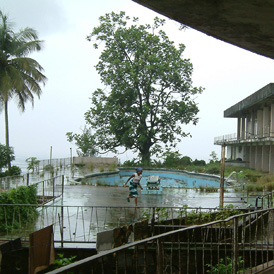
Overlooking the Bridge was the huge vantage point of the Intercontinental Hotel – a gutted high-rise.
In the foyer was a box of pamphlets from the 1970s showing Liberians in big afros relaxing by the pool, the coffee lounge serving teas and cakes.
Now the pool area was the front line and, as the picture shows, locals had to run the gauntlet of LURD snipers to get in and out.
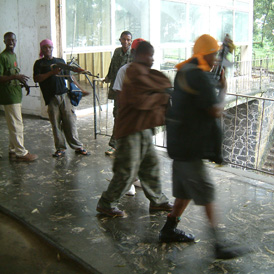
The building had been taken over by a more “elite” band of militia with sniper rifles and the more sophisticated weaponry.
On the way up the cracked concrete steps you could see women cooking in dark concrete rooms, and then at the top the sniper would take turns firing out a round across the bridge and water below.
The response would come immediately – and everyone would dive for cover.
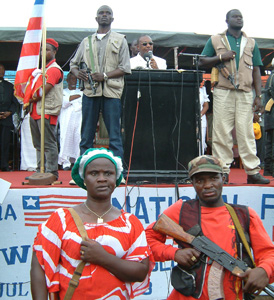
A couple of times a week Charles Taylor would make appearances for journalists, always impeccably turned out, his wife Jewel at his side.
The first time I saw him a man called Dr K A Paul – a supposed spiritual envoy of God and of peace – had touched down in a jumbo, with the words Global Peace Ambassador emblazoned on the side, and the two made an appearance at the national stadium, both beseeching God to intervene.
In the bowels of the stadium hundreds of Liberians occupied whatever space they could .. hundreds of thousands more wandered Monrovia’s streets, desperate for food, money, and safety.
Everyone knew that if Taylor went, this would stop. But Taylor would not go.
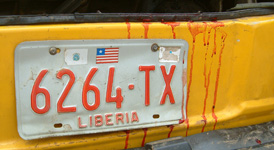
Every couple of days LURD would mortar the city, and people would take shelter wherever they could; but as much of the Monrovia was clapboard and tin, there were few places where sanctuary could be found.
The MSF clinic just up the road would get the intake of the horribly injured with every bombardment, and locals for whaetever reason woyuld gather there for safety. Local yellow taxies were used to ferry the injured to the clinic.
After weeks of fighting a truce was called.
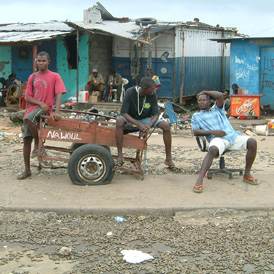
We crossed the bridge to the LURD side – manning their checkpoint were children with toy rucksacks, a huge foam hand – and guns.
A van left at one end of the bridge had been shredded – the ground was carpeted with spend cartridges (pictured).
Nearby a bad of kids had looted a paint store – and painted themsleves and their guns with lurid colours.
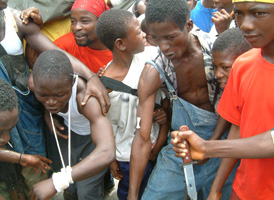
These were kids out of control beyond any ASBO order.
Finally, after adult intervention arrived in the shape of the arrival of ECOMOG West African peacekeeping troops, Taylor stepped down for the good of the country.
The streets were packed with joyous Liberians welcoming them, but the child fighters gathered for a final menacing show of strength.
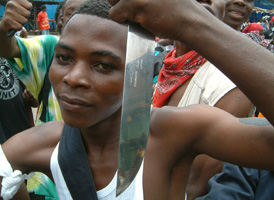
He had ransacked the state, unleashed the dogs of hell militarising thousands of children, allegedly looted the state coffers and left Liberia in ruins.
In Monrovia the damage has been reversed by a massive UN peacekeeping effort and a decade of better, if not perfect, governance, but he poisoned the future.
Many of the children and young men who were disarmed in exchange for a few hundred dollars are now jobless men, and many miss the memory of power the guns and craziness gave them, and often demonstrate for his return.
Charles Taylor will likely spend the rest of his life in prison, but there are countless thousands of people in Liberia who will never recover from his misrule.
(all pictures: copyright Ben de Pear)